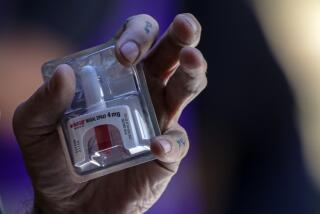U.S. should reclassify prescription painkiller to cut rampant theft
In his 30 years as a pharmacist, including three at a CVS Caremark store in Northern California, Wayne Wilson said it was all too common for drugstore employees to steal prescription drugs, which would often make their way to the black market.
“It happens far more often than people realize,” he told me. “I used to be shocked. I’m not shocked any more.”
Wilson said he personally intervened after a CVS pharmacy worker in Eureka was caught slipping painkillers into his pocket. That worker was arrested and fired, he said.
Pharmacists in other CVS stores have shared similar experiences, Wilson said, but they didn’t always report such incidents to management. He said some pharmacists feared reprisal from the company for not supervising workers closely enough.
“You’d basically be reporting yourself,” Wilson said.
I heard numerous such anecdotes from pharmacists throughout the state after reporting Tuesday that CVS could face as much as $29 million in fines for allegedly losing track of prescription painkillers at stores in Modesto, Fairfield, Dixon and Turlock.
Officials at the Drug Enforcement Administration and the California Board of Pharmacy said that more than 37,000 pills, primarily the generic version of Vicodin, were apparently missing. Each has a street value of as much as $10, they said.
Michele Leonhart, head of the DEA, testified before Congress last year that abuse of prescription medications “is the nation’s fastest-growing drug problem.”
She said there are more people taking painkillers and similar drugs for non-medical reasons — diversion, in official-speak — than there are users of cocaine, heroin and hallucinogens combined.
How do so many prescription drugs make their way to the street? Often they’re obtained by people with legitimate prescriptions who choose to sell some or all of their pills. Some receive prescriptions for the same drug from multiple doctors.
In many cases, though, the pills are stolen from manufacturers, distributors, hospitals and drugstores.
As I reported Tuesday, DEA affidavits related to the missing CVS painkillers suggested that employee theft is suspected.
The affidavits said federal investigators began looking into CVS stores in California after a company employee in Rocklin, northeast of Sacramento, was spotted hiding a bottle of hydrocodone in her pants.
Hydrocodone is a narcotic painkiller sold under various brand names, including Vicodin and Norco. It’s the most frequently prescribed opiate in the United States with more than 140 million prescriptions dispensed annually, according to the DEA.
“There’s more hydrocodone on the street these days than in the pharmacy,” said Vicken Gulvartian, a pharmacist in Hollywood. “It’s an industry.”
How can that be remedied?
Tighter security is one obvious answer. In 2012, drugstore chains reported 517 armed robberies of prescription meds to the DEA. They reported 851 instances of employee theft during the same period.
And that may be just the tip of the iceberg. Pharmacists say heavy workloads and limited staffing make it difficult to stay on top of what drugstore clerks and technicians are doing.
Background checks for all pharmacy employees are required by federal law. But with median pay for technicians running about $30,000 a year, some employees may find ready access to lucrative drugs too great a temptation.
“It’s a challenge,” said Sam Lee, who works part-time as a pharmacist at his family’s drugstore in South Los Angeles and part-time at the pharmacy of a major supermarket chain. “We’re just so busy all the time. It’s hard to keep up.”
Bill Bradshaw, a Walgreens pharmacist in Fort Worth, said there are cameras in almost all drugstores. “But they can’t see everything,” he said. “There are plenty of little corners where someone can hide.”
Wilson, the Northern California pharmacist who worked for CVS from 2009 to 2012 before leaving for medical reasons, said surveillance cameras aren’t a very effective deterrent.
“It’s not like the company has someone watching what’s going on all the time,” he said. “They only check the tapes after they have reason to suspect someone.”
Wilson also said CVS and other big pharmacy chains may be reluctant to report all instances of employee theft to federal and state authorities.
“They often like to handle things quietly, firing or suspending people,” he said. “They don’t want to look bad to regulators.”
Michael DeAngelis, a CVS spokesman, denied such allegations.
“CVS pharmacy takes very seriously the challenge of combating prescription drug abuse and diversion to help support safer communities, and we recognize the important role our pharmacists and technicians play on the front lines of solving this problem,” he said.
DeAngelis said CVS is “enhancing” its internal auditing procedures to better monitor drug inventories and is implementing “new storage and control measures for highly diverted controlled substances.”
“Drug diversion is a serious criminal offense that we work hard to prevent in our pharmacies,” he said. “We have security procedures in place to detect drug diversion when it occurs and we cooperate fully with law enforcement and regulators in any investigation into these incidents.”
All the pharmacists I spoke with said the best way to curb theft of hydrocodone would be to change its regulatory status.
Hydrocodone is classified by the government as a Schedule III drug, which means it represents only a “moderate to low” risk of being habit forming and has little potential for abuse.
Schedule II drugs have a higher potential for abuse and addiction. Cocaine and PCP are in this category.
Schedule I drugs are considered the most dangerous. They include heroin, LSD, ecstasy and, weirdly, marijuana.
The DEA last month proposed switching hydrocodone from Schedule III to Schedule II, arguing, correctly, that “hydrocodone is one of the most abused drugs in the nation.”
For drugstores, such a change would have an immediate and significant impact. It would mean that hydrocodone would no longer sit out on pharmacy shelves with other Schedule III meds, easily accessed by workers.
Instead, it would be kept under lock and key with other Schedule II drugs, requiring a pharmacist’s involvement for a technician to gain access.
Reclassifying hydrocodone is a simple and common-sense move. The big drugstore chains, however, think otherwise.
The National Assn. of Chain Drug Stores, the National Alliance of State Pharmacy Assns. and other industry groups banded together last year to oppose tighter restrictions on hydrocodone.
“Rescheduling will have a profoundly negative impact on patients who legitimately need these medications and a negligible impact on drug abuse,” they wrote in a November letter to Health and Human Services Secretary Kathleen Sibelius
The groups said a Schedule II classification for hydrocodone would make it harder for people to obtain the drug because doctors would no longer be able to call in a prescription. Patients instead would have to hand-deliver prescriptions to pharmacists.
The industry groups said this requirement could force people “to travel long distances and suffer significant discomfort to see their physician for refills and to have their prescriptions filled.”
That’s a cynical way of saying that drugstore chains are worried about less-easy access to hydrocodone cutting into sales of one of their bestselling drugs.
The reality is this: Hydrocodone has no business being a Schedule III drug.
If reclassifying hydrocodone is the best bet for helping to keep this widely abused narcotic off streets — as both the DEA and the Food and Drug Administration believe — then such a change isn’t just warranted; it’s required.
Otherwise, there’s a word for what the big drugstores are doing — enabling.
David Lazarus’ column runs Tuesdays and Fridays. He also can be seen daily on KTLA-TV Channel 5 and followed on Twitter @Davidlaz. Send your tips or feedback to david.lazarus@latimes.com.







